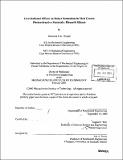| dc.contributor.advisor | August F. Witt. | en_US |
| dc.contributor.author | Wiegel, Michaela E. K. (Michaela Emilie Kurt), 1973- | en_US |
| dc.contributor.other | Massachusetts Institute of Technology. Dept. of Mechanical Engineering. | en_US |
| dc.date.accessioned | 2006-03-24T16:09:17Z | |
| dc.date.available | 2006-03-24T16:09:17Z | |
| dc.date.copyright | 2003 | en_US |
| dc.date.issued | 2003 | en_US |
| dc.identifier.uri | http://hdl.handle.net/1721.1/29626 | |
| dc.description | Thesis (Ph. D.)--Massachusetts Institute of Technology, Dept. of Mechanical Engineering, 2003. | en_US |
| dc.description | Includes bibliographical references (leaves 206-213). | en_US |
| dc.description.abstract | Photorefractivity is the modulation of index of refraction due to nonuniform illumination, and numerous applications have been demonstrated utilizing this nonlinear optical property. However, commercial production is seriously impeded by the inability to produce bulk material with the homogeneity of opto-electronic properties that is required for device applications. Bismuth Silicate, Bi12SiO20, (BSO) is a photorefractive material with outstanding properties including a fast response time and high sensitivity is studied. Its photorefractivity is due to a native defect whose exact nature and origin have not been unambiguously determined. Motivation for current research arose from unexplained optical variations observed in BSO that implicate convective interference as playing a role in native defect formation. Microgravity growth experiments are proposed in order to establish a controlled, convection-free environment to study the origin and nature of the critical native defect. This work aims at resolving critical aspects of performing quantitative microgravity growth experiments that include the interaction of BSO melts with its confinement material; development and characterization of a vertical Bridgman-Stockbarger growth system with a quantifiable, reproducible, and controllable thermal environment; and Bridgman-Stockbarger growth experiments. A comparative analysis of crystals was done in order to establish the relationship between variations in opto-electronic properties as a function of changes in growth conditions. Wetting experiments revealed the sessile drop method to be inappropriate for the BSO-platinum system due to grain boundary pinning. No fundamental difference between the wetting behavior in a terrestrial and a low gravity environment was observed. | en_US |
| dc.description.abstract | (cont.) Results from the comparative analysis indicate a lower defect concentration in Bridgman-Stockbarger material as compared to Czochralski material. The ambient atmosphere during processing and high temperature annealing was found affect material response, including removal of the photochromic response and decrease of carrier lifetime. The lack of the critical defect in hydrothermal BSO, and its existence in all melt grown material indicates that the melt plays a fundamental role in its formation. Clustering in the melt is implicated in the literature from nonlinear melt properties. It is therefore hypothesized that these clusters in the melt act as precursors for native defect formation and subject to gravitationally induced convection. The support of the National Aeronautics and Space Administration is gratefully acknowledged. | en_US |
| dc.description.statementofresponsibility | by Michaela E.K. Wiegel. | en_US |
| dc.format.extent | 213 leaves | en_US |
| dc.format.extent | 17815150 bytes | |
| dc.format.extent | 17814957 bytes | |
| dc.format.mimetype | application/pdf | |
| dc.format.mimetype | application/pdf | |
| dc.language.iso | eng | en_US |
| dc.publisher | Massachusetts Institute of Technology | en_US |
| dc.rights | M.I.T. theses are protected by copyright. They may be viewed from this source for any purpose, but reproduction or distribution in any format is prohibited without written permission. See provided URL for inquiries about permission. | en_US |
| dc.rights.uri | http://dspace.mit.edu/handle/1721.1/7582 | |
| dc.subject | Mechanical Engineering. | en_US |
| dc.title | Gravitational effects on defect formation in melt grown photorefractive materials : bismuth silicate | en_US |
| dc.type | Thesis | en_US |
| dc.description.degree | Ph.D. | en_US |
| dc.contributor.department | Massachusetts Institute of Technology. Department of Mechanical Engineering | |
| dc.identifier.oclc | 53370275 | en_US |
